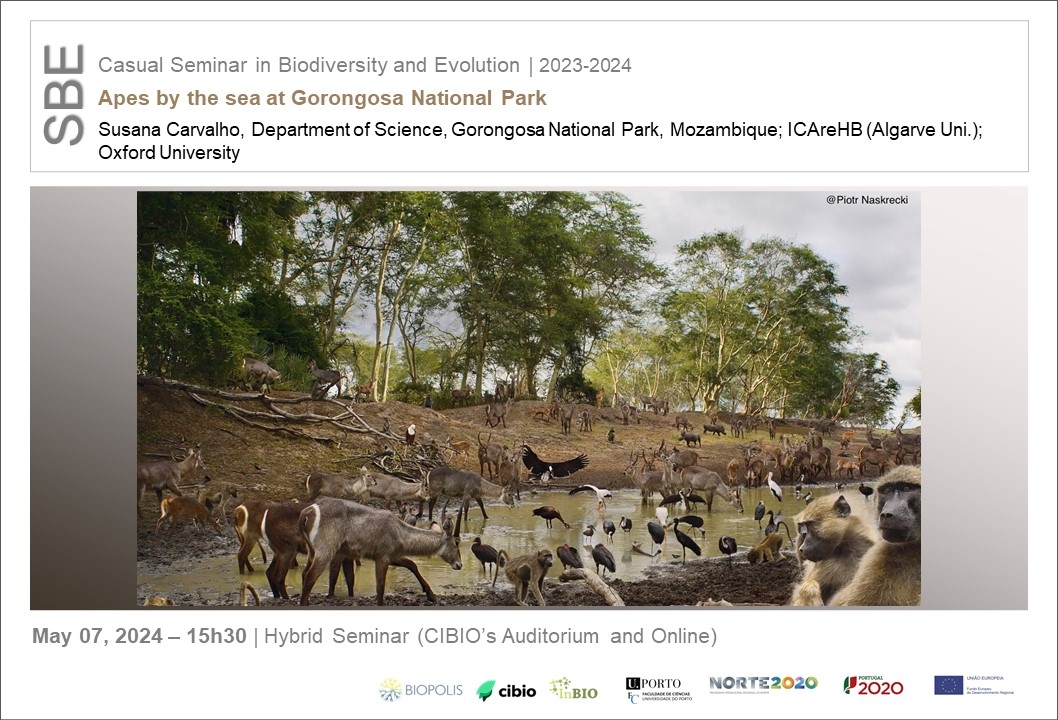Apes by the sea at Gorongosa National Park
Event
CASUAL SEMINAR IN BIODIVERSITY AND EVOLUTION
May 07th, 2024
Susana Carvalho, Department of Science, Gorongosa National Park, Mozambique; ICAreHB (Algarve Uni.); Oxford University | 15h30 | Hybrid Seminar

CASUAL SEMINAR IN BIODIVERSITY AND EVOLUTION
It has long been clear that an understanding of human origins must involve the origins and early evolution of the African apes. Current molecular evidence indicates that African apes shared a last common ancestor in the Miocene between 8 and 12 Ma (million years ago). The earliest record of actual hominins is sparse and controversial, but dates to about 6 or 7 Ma. This means that there may be a gap of up to 6 million years between the last common ancestor of the African apes and the earliest hominin fossils. This gap is the focus of our project. Considerations of plant and animal distributions on a continental scale provides powerful biogeographic insights relevant to hominin origins. Jonathan Kingdon has shown that the main biogeographic pattern in Africa consists of a boreal or latitudinal realm that includes the Guineo-Congolian forests, and an austral or longitudinal realm that includes the coastal forests of eastern Africa, with these two realms separated by an arid corridor that emerged during the Miocene. Under these conditions, and under increasing genetic isolation during the Miocene, eastern coastal forest apes adapted by increasing terrestriality and expanding their diet by foraging for ground resources. These new ecological features and barriers to gene flow thus set the stage for the evolution of an eastern ground ape, i.e., the earliest hominins. Until now, the paleontological data to test this hypothesis has not been available, but new fossils from Gorongosa National Park in Mozambique are changing this.
Carvalho is a primatologist, paleoanthropologist-archaeologist. A Professor at Oxford University until 2023, she is currently an Associate Director at Gorongosa National Park. A pioneer of Primate Archaeology, she studied tool use by wild chimpanzees in Bossou, Guinea, while carrying out archaeological research in Lake Turkana, Kenya, focusing on the origins of technology. She leads the Paleo-Primate Project, where a team from 14 countries is carrying out an unprecedented approach to understanding primate origins and adaptations in the extreme South of the African Rift System. Carvalho directs the excavations at the new fossil sites in Gorongosa, as well as the primatological work. Her supervision of graduate research includes novel approaches to human evolution, such as the ‘Bones of Predation Project’, ‘Landscapes of Fear’ or ‘Evolution of Bipedalism and Predation’. Since 2018, Carvalho directs the Interdisciplinary Field School in Human Evolution. In January 2021 she was elected Vice-President of the IPS for EDEI. Since 2024, Carvalho coordinates the Primate Models for Hominin Evolution, at ICArEHB. She received the Philip Leverhulme Prize, and the British Academy Mid-Career Fellowship.
[Host: Maria Joana Silva, Biodiversity of Deserts and Arid Regions - BIODESERTS]
